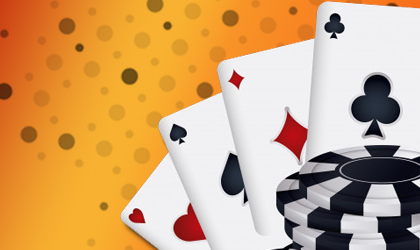The Importance of Pot Odds in Texas Hold’em

Bill Burton 02:51 Aug 23rd, 2006 Poker
Many players don’t understand that Poker like other casino games is a game of about math. Understanding the math of the game is very important to playing winning poker. You can have the identical hand and one time it will be correct to call and the next time it will be correct to fold. How can that be? The answer is the pot odds.
Poker players get their money in the pot when the pot odds justify making the call and pass when the money in the pot is not enough to call. The relationship between the amount of money in the pot and the cost of calling a bet is known as Pot Odds.
Many low limit and higher limit Texas Hold'em players have no concept of pot odds and how it can affect their profitability. They only look at their two cards to see if there is a chance that they could win. They don't understand the reasoning for playing drawing hands against a large field of opponents. Some hands that are profitable against many players will be a loser or break-even hand with fewer players in the hand.
Understanding the Odds Let’s look at an example to see how pot odds can affect your profitability. Every poker player has heard the advice to “Never draw to an inside straight.” In many situations, it is truly the correct advice, however not always.  You are playing in a $2/4 limit game. You hold the Ten and 9 of clubs: The board cards are Kd – 7s- 6h – 2c. It will cost you $4 to see the river card.
You are playing in a $2/4 limit game. You hold the Ten and 9 of clubs: The board cards are Kd – 7s- 6h – 2c. It will cost you $4 to see the river card.
You are drawing to an inside straight. The only card that can help you is an 8 and there are four of them left in the deck. You have two holed cards and there are four community cards on the board so you have seen six of the fifty-two cards in the deck. This means there are 46 unseen cards left. In poker, the unseen cards that can make your hand a winner are called your “outs”. So for the inside straight draw you have four outs to make your hand.
Four times you will catch the 8 and 42 times you won’t so the odds are 42 to 4 or 10.5 against you. You get this figure by dividing 46 by 4 and you get 11.5. Subtract 1 and you have 10.5 to 1.
In order to make a call of $4 to try for an inside straight the pot must contain $42 in order for you to break even and more than that if you want to make a profit. Here is where that figure comes from: You will lose $42 for the 10.5 times you don’t catch and 8($4 bet x 10.5 = 42.) The one time you do catch the 8 you will make money in the long run if the pot contains more than $42 and you will lose if the pot contains less than $42.
Remember, The Pot Odds are relationship between the money in the pot and the price of a bet you must make to call. If the pot contains $44 and the size of the bet you must call is four dollars we divide the $48 by $4 and we get 12, which means that the pot odds are 12 to 1. The odds against making an inside straight are 10.5 to one. If the pot odds are greater than the odds against making your hand you should call. If the pot odds are less you should fold. In this case, you would call.
In this situation if the pot contained $20 and it cost you $4 you would only be getting 5 to 1 pot odds and it would not be profitable to make the call.  Breaking It Down Let’s break down both situations above. Suppose you find your self in this situation with an inside draw 11 times and play it out according to the pot odds you are getting. For simplicity, we will say the odds of making the inside straight are 10 to 1. Which means you will win this hand 1 time for every 11 that you play it.
Breaking It Down Let’s break down both situations above. Suppose you find your self in this situation with an inside draw 11 times and play it out according to the pot odds you are getting. For simplicity, we will say the odds of making the inside straight are 10 to 1. Which means you will win this hand 1 time for every 11 that you play it.
In the first situation, there is $48 in the pot and it will cost you $4 to call. The ten times that you don’t make the straight, you will lose $40. (4x10). The one time that you make it, you will win $48 pot for a profit of $8. (48- 40 = 8)
In the second situation, there is $20 in the pot. The ten times that you don’t make it, you will lose $40. (4x10).The one time that you do make it you will win $20 pot for a loss of $20. 20 – 40 = minus 20)
The odds for making the inside straight draw doesn’t change. It remains constant but the profitability of making the play changes with the Pot odds.
Now you can see why we say poker is a game about math.
On This Page



